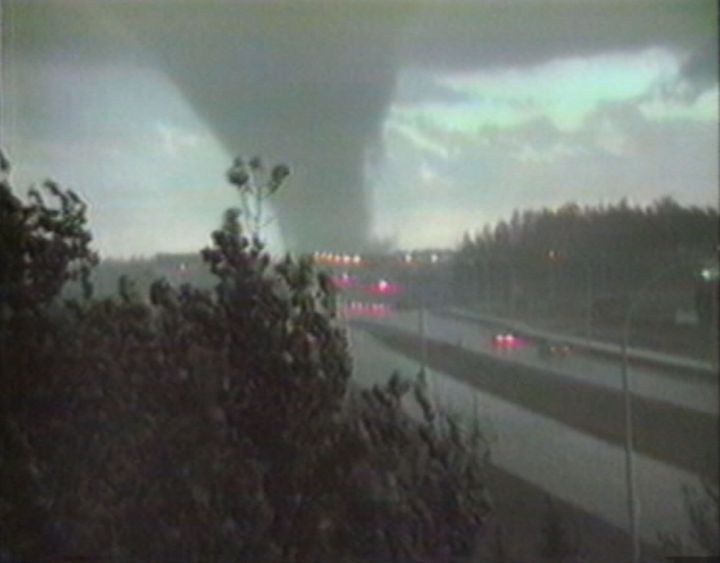It’s been 30 years since an F-4 tornado ripped through Edmonton and Strathcona County, killing 27 people and injuring hundreds of others. Black Friday is a day few who lived through it will ever forget.

“I keep a picture of this in my cubicle because it’s something we’d like to keep in the forefronts of our minds,” said Kyle Fougére, a meteorologist in Environment Canada’s Prairie and Arctic Storm Prediction Centre.
READ MORE: Edmonton marks sombre 30-year anniversary of deadly Black Friday tornado
A lot has changed in the past 30 years when it comes to technology and communication. While Dan Kulak, meteorologist at Environment Canada, said the warnings went out well in advance of the 1987 storm, forecasting has come leaps and bounds in the past three decades.
“To create what we call a satellite loop of the images of the clouds moving on your monitor, we had to actually print them off and film them and create like a still animation like a Disney studio,” Kulak explained. “Nowadays, you can get this on the Internet and on your tablet.
“We can hook up our Internet and look and have livestreaming video of what’s happening 12 time zones away on the other side of the planet.”
Plus, social media has helped when it comes to the immediacy of severe weather situations.
“It’s an instantaneous world and I think the awareness of what’s happening out there is that much quicker,” Kulak said. “The technology, the social media, the communications abilities we have is leaps and bounds (better).”
READ MORE: How technology can help warn you about the next big storm
It was a Friday afternoon when the twister touched down just east of Leduc and made its way north through Mill Woods.
“It gained in strength as it was moving up and it reached full intensity basically just as it passed north of the Sherwood Park Freeway,” Fougére said, adding it measured as an F-4 as it came through this area.
“Twelve of the 27 deaths that occurred with the Edmonton tornado happened just in this east industrial area as it was at full intensity.”
Watch below: In 1987, Global Edmonton (then ITV) produced this documentary looking back at Black Friday.
The twister was 1.3 kilometres wide at its widest, and while it weakened as it crossed the river, it still measured between an F-3 and F-4 intensity as it passed through the Evergreen Mobile Home Park, where 15 people were killed.
The tornado was measured on the original Fugita Scale. Now, weather agencies in Canada use the Enhanced Fugita Scale or EF-Scale, which is a more modern and improved version of the original system. The new scale has more indicators with which to rate damage.
Fougére said tornadoes like the one Edmonton saw 30 years ago are extremely rare in Canada, but they can happen.
“We do have days with the potential for this,” he explained. “It’s a rare event but it’s not unheard of and there’s certainly potential for it in the Canadian Prairies in the summer.”
READ MORE: A closer look at tornadoes in Canada
That’s why it’s important to be prepared and know what type of weather is possible for your area.
“These events can happen in our area and we have to be prepared for it,” Fougére said.
Alberta has seen two of the four deadliest tornadoes in Canadian history: Black Friday, which killed 27 people and the Pine Lake tornado in July 2000, which killed 12 people.
READ MORE: Residents recall Pine Lake tornado, 15 years later
Canada has recorded just one F-5 tornado, in Elie, Man. in 2007. No fatalities or serious injuries were reported.
Learning from the disaster of Black Friday, Alberta created its emergency alert system, the first of its kind in Canada.
The Alberta Emergency Alert app sends both critical and informative alerts to IOS and Android users. Last year, the app warned the public of 13 tornadoes.
To download the Alberta Emergency Alert app, or sign up for other social media alerts, visit the government’s website.
READ MORE: Tornado warnings and other emergency alerts coming to your mobile phone next year
By April 2018, an emergency alert will be sent directly to people’s mobile phones, whether or not they have the app.
“We’re going to be going to a whole new distribution platform called wireless public alerting,” Tim Tryteen, with the Alberta Emergency Management Agency, said. “You won’t have to do anything. It will come directly to your smartphone if you’re in the area under threat.
“It will come almost like a text message directly to you… complete with a common alerting tone which is the tone we’re all so familiar with.”
Watch below: Edmonton Fire Chief Ken Block was a seven-year veteran of the fire department on Black Friday. He recalls being deployed to southeast Edmonton, and touches on how emergency preparedness has changed over the past 30 years.





















Comments